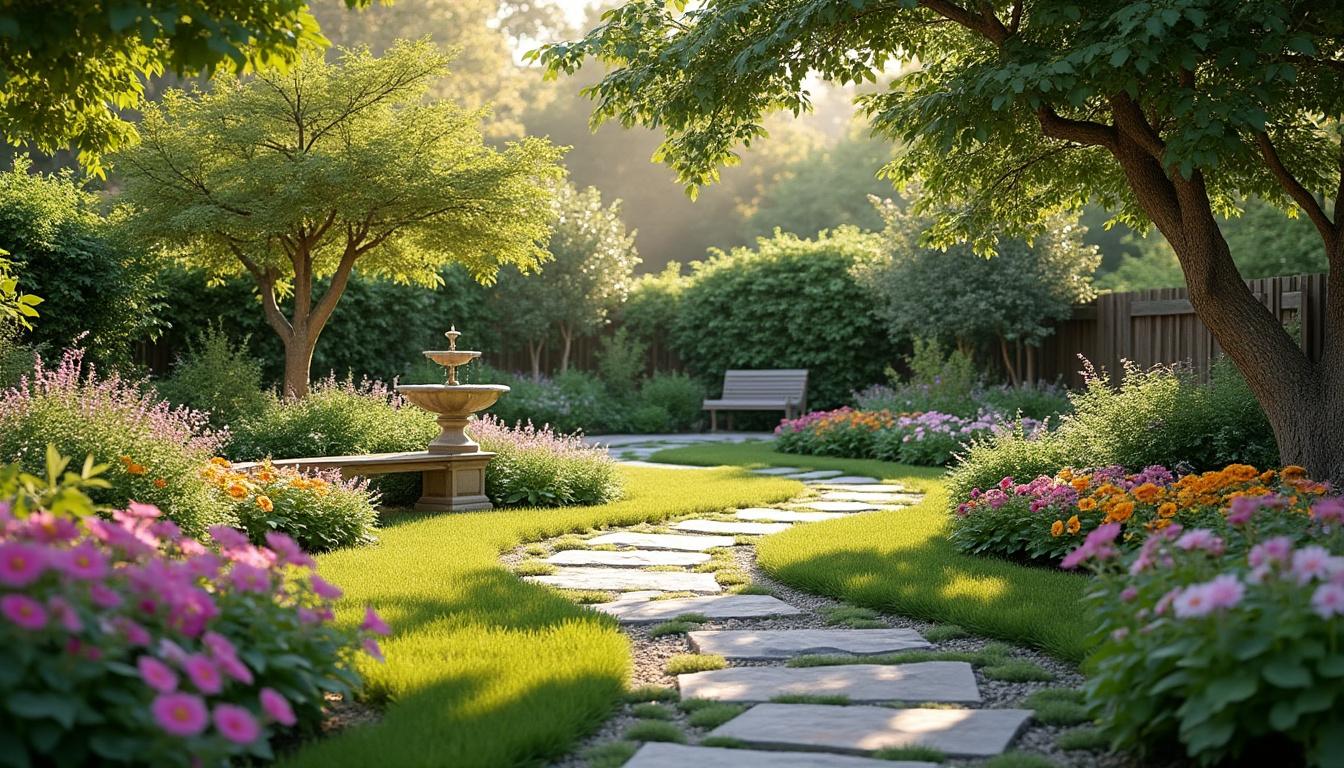Crafting an outdoor space that endures both time and trends forms the cornerstone of timeless garden design. In an age when aesthetic fashions fluctuate rapidly, creating a garden with lasting charm offers not only visual pleasure but also increases property value and invites continual engagement with nature. Experts emphasize the importance of melding traditional elements with modern sensibilities to develop an environment both functional and graceful. From the use of natural materials to preserving the integrity of mature trees, every design choice contributes to a sense of place and permanence. This article explores six expert-approved strategies, enriching the dialogue around garden longevity with detailed insights and practical applications suitable for today’s garden enthusiasts and professionals alike.
Strategic Selection of Perennials and Plant Palettes for Timeless Garden Design
The foundation of any garden that aspires to timelessness lies in its selection of flora. Perennials, with their capacity to return year after year, embody the essence of durability in landscaping. Renowned landscape designer Julie Jordin advocates for a soft, enduring color palette emphasizing gentle pinks and purples. These shades provide an elegant, understated backdrop that aligns with both classical and contemporary tastes. Species such as catmint, ‘Millennium’ allium, ‘Cinderella’ milkweed, and clary sage offer robust blooms without overpowering the garden’s overall ambiance.
Choosing perennials is not merely a matter of color but also their resilience and compatibility with local climate conditions, ensuring minimal upkeep. Incorporating plants from trusted nurseries like Monrovia and Proven Winners supports a sustainable garden that harmonizes with its environment.
In practice, layering perennials in borders ensures continuous interest throughout seasons. For instance:
- Early blooming alliums establish initial vibrancy.
- Mid-season catmint provides enduring foliage and color.
- Late-summer milkweed attracts pollinators, enhancing ecological health.
Such a curated approach stabilizes the garden’s visual appeal over time, resisting fleeting trends often seen in bold, transient planting schemes.
| Plant | Bloom Time | Care Requirements | Landscape Role |
|---|---|---|---|
| Catmint | Early Summer to Fall | Low water, full sun | Border filler and fragrant layering |
| ‘Millennium’ Allium | Mid to Late Spring | Well-drained soil, sun | Structural vertical accents |
| ‘Cinderella’ Milkweed | Late Summer | Moderate water, sun to part shade | Pollinator attractor & color focal point |
| Clary Sage | Summer | Full sun, drought tolerant | Aromatic herb and texture provider |
For gardeners keen to elevate their sustainable practices, integrating native species alongside these perennials fosters biodiversity and aligns with the principles championed by organizations such as Gardenista and Gardener’s Supply Company.
Integrating Classic Elements to Establish Timelessness and Ease in Outdoor Spaces
Classic garden components provide an anchor for design that withstands the shifts in popular style. Seating choices, materials, and landscaping patterns established through centuries of garden design exude a sense of familiarity and comfort. For example, Adirondack chairs have proven timeless due to their simplicity, ergonomic shape, and natural wooden texture, making them a staple for firepit areas or patios.
Landscape professionals frequently envelop such classic furniture with mass plantings like lavender, which boasts both aesthetic and aromatic appeal. This combination harmonizes relaxation, sensory delight, and architectural sturdiness within the garden space.
Experts from Burton McKinnon’s studios and brands like Terrain and Rustico endorse blending these elements with modern amenities discreetly to sustain ease of use. The arrangement should invite socializing while maintaining serene solitude when desired.
- Choose furniture with natural materials and finishes that age gracefully.
- Incorporate timeless plantings such as lavender or boxwood for structure.
- Use symmetrical layouts balancing functionality with beauty.
The balanced approach champions gardens that act as living spaces, increasing the value and enjoyment of outdoor areas year-round. Additional inspiration for balance in garden furnishings and classic designs is available via curated gardens on Garden Inspirations & Yard Designs.
| Classic Feature | Function | Recommended Brands | Design Benefits |
|---|---|---|---|
| Wooden Adirondack Chairs | Comfortable seating | Rustico, Terrain | Natural finish, durable, easy maintenance |
| Mass Lavender Planting | Aromatic borders | Proven Winners | Visual appeal, insect repellent |
| Symmetrical Garden Beds | Ordered planting | Gardenista | Focal clarity, timeless appearance |
Utilizing Natural and Reclaimed Materials to Enhance Garden Character and Sustainability
Implementing natural and reclaimed materials not only underscores a garden’s connection to nature but also infuses it with historic character and reduces environmental impact. Landscape designers increasingly incorporate elements such as reclaimed shingles, antique granite curbing, or driftwood arches to harmonize with a property’s heritage, as seen in well-executed projects on Nantucket.
For instance, the use of reclaimed roofing shingles coupled with traditional strap hinges crafts garden structures—in particular, backyard sheds or storage—that appear as though originally built alongside the main dwellings. This strategy hides utilitarian necessities such as generators or irrigation systems behind a facade that respects the garden’s aesthetic integrity.
- Use reclaimed wood or stone for garden borders and steps.
- Integrate found driftwood or natural sculptural elements created by artists like Kelley Jepson.
- Incorporate antique or vintage hardware to add authenticity.
Natural materials not only age beautifully but also establish a tactile and visual warmth absent in industrial alternatives. Terraforming these elements into garden design intensifies the sense of a “been-here-forever” ambiance often sought by designers and homeowners alike.
| Material | Use Case | Sustainability Aspect | Visual/Functional Benefit |
|---|---|---|---|
| Reclaimed Shingles | Shed/cladding | Reduces waste, preserves history | Authentic historic look |
| Driftwood | Garden arches/sculptures | Natural found object, no manufacturing | Unique organic texture |
| Antique Granite Curbing | Garden steps/edging | Long-lasting, recycled stone | Timeless solid foundation |
Brands such as Ferguson and Bamboo Garden increasingly support such sustainable sourcing, ensuring the materials are both eco-friendly and aesthetically superior. Resources like Green Drenching Gardening Tips provide additional strategies for eco-conscious garden planning.
Discreet Integration of Modern Amenities to Preserve Garden Aesthetic and Functionality
Modern living demands certain conveniences be incorporated within outdoor spaces, yet their presence need not detract from the overall design harmony. Balancing technology and nature often involves smart placement and thoughtful concealment.
When local preservation rules restrict visible alterations, as was the case with historic properties prohibiting pools near the main house, placing amenities like swimming pools behind secondary structures maintains visual coherence. Utilizing natural plantings such as Nantucket blue hydrangea and simple lawn areas around these features visually integrates modern elements without hardscaping overuse.
- Locate modern amenities strategically behind or away from main visual axes.
- Screen necessary mechanical systems through natural plantings or discreet structures.
- Choose landscape-friendly technologies promoting sustainability.
This approach aligns with practical advice favored by experts at Gardener’s Supply Company and Veranda magazine, optimizing outdoor livability while respecting historic or natural garden settings. For inspiration on blending utility with beauty, the article Home Garden Outdoor Exploration offers relevant insights.
| Modern Amenity | Concealment Technique | Benefits | Design Impact |
|---|---|---|---|
| Swimming Pool | Position behind garage, natural screening | Preserves historic façade, easy maintenance | Seamless integration |
| Generator/Irrigation Systems | Separate shed with reclaimed materials | Functional, hidden utilities | Maintains aesthetics |
| Outdoor Lighting | Subtle fixtures with warm tones | Safety and ambiance | Enhances garden mood |
Preservation of Mature Trees as a Keystone in Timeless Garden Frameworks
Incorporating existing mature trees within landscape design lends immediate maturity, scale, and ecological richness. Rather than clearing these treasures, experts like those affiliated with Burton McKinnon promote working around established trees to craft layered, inviting gardens.
The presence of mature flora creates a ‘been-here-forever’ feeling that is central to timelessness. For instance, substantial boxwoods planted at the base of native chokecherries enliven a sloped garden, strand well against antique granite curbing steps enhancing the sense of grounded history.
- Design planting beds that respect root zones and allow for healthy tree growth.
- Employ companion planting to underline tree features and promote biodiversity.
- Preserve natural canopy patterns for shade and habitat.
Workshops and resources from companies like Gardenista and Monrovia deliver practical guidance on managing mature trees within evolving gardens, ensuring longevity and harmony at every level. Additional strategies can be found at Maximize Summer Garden Tips, useful for maintaining healthy, timeless landscapes throughout varied climates.
| Tree Species | Companion Plantings | Design Benefits | Maintenance Tips |
|---|---|---|---|
| Chokecherry | Boxwood, native wildflowers | Shade, wildlife habitat | Protect roots, mulch yearly |
| Oak | Fern, hosta | Structural dominance | Prune for health, avoid compaction |
| Maple | Shade-loving perennials | Seasonal color | Water deeply, monitor pests |
Frequently Asked Questions About Creating a Timeless Garden Design
- What is the key to selecting plants for a timeless garden?
Emphasize perennial plants with enduring colors and robust growth habits, such as those in soft pink and purple palettes, ensuring sustainability. - How can reclaimed materials improve garden design?
They add historic character and reduce environmental impact while blending practical structures seamlessly into the garden. - Where should modern amenities be placed in a historic garden space?
Ideally, position them behind secondary structures or use natural screenings to maintain aesthetic coherence. - Why preserve mature trees instead of planting new ones?
Mature trees offer immediate scale and character, enhancing garden maturity and providing ecological benefits. - Which brands offer reliable resources and plants for timeless garden design?
Burton McKinnon, Monrovia, Proven Winners, Gardenista, and Gardener’s Supply Company provide excellent quality and guidance.

